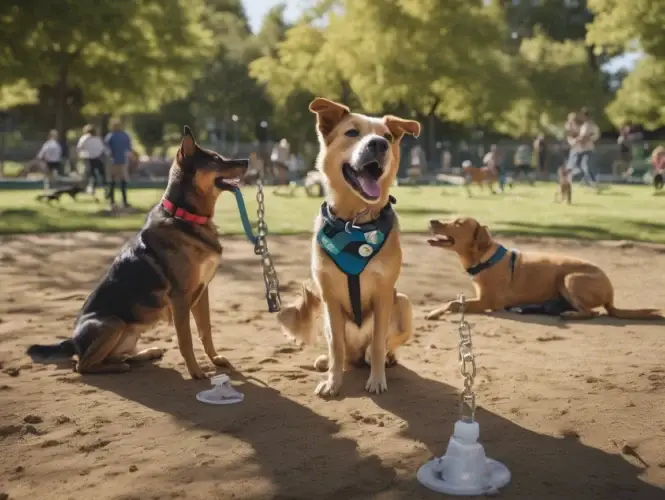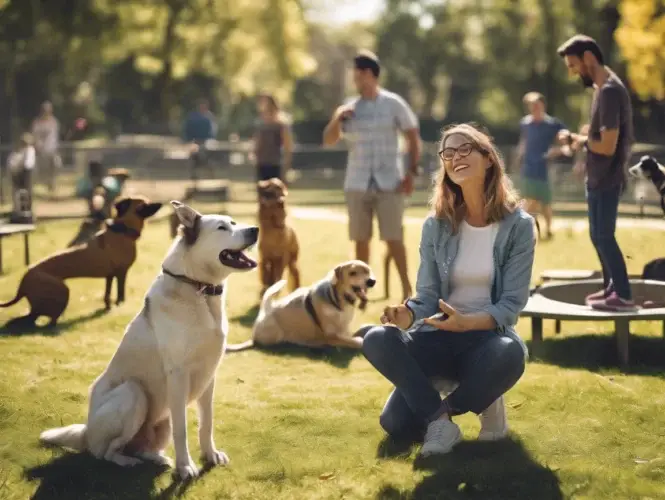Introduction
Dog parks offer incredible opportunities for exercise and socialization, but they also present unique safety challenges. With proper preparation and awareness, you can minimize risks and ensure every visit is both fun and secure. This comprehensive safety guide covers everything from pre-visit health checks to emergency response procedures.
Health and Medical Preparedness
Vaccination Protocols Beyond basic vaccinations, consider additional protection based on your local area’s disease prevalence. Consult your veterinarian about vaccines for Lyme disease, leptospirosis, and canine influenza, which can spread in social environments like dog parks.
Parasite Prevention Maintain year-round flea, tick, and heartworm prevention. Dog parks can be hotspots for parasite transmission due to the high concentration of animals and potential exposure to wildlife.
Health Screening Before Each Visit Perform a quick health check before leaving home. Look for signs of illness, injury, or behavioral changes that might make park visits inadvisable. Dogs who are unwell, in heat, or showing signs of stress should stay home.
Physical Safety Measures
Collar and ID Requirements Ensure your dog wears a properly fitted collar with current identification tags, even in off-leash areas. Consider microchipping as a permanent form of identification. Quick-release collars are recommended to prevent choking if dogs get tangled during play.
Paw and Pad Protection Check the ground temperature before allowing your dog to run freely. Hot pavement, rough surfaces, or ice can damage paw pads. Consider protective booties for extreme conditions or dogs with sensitive feet.
Hydration and Heat Safety Bring fresh water and a portable bowl, especially during warm weather. Watch for signs of overheating: excessive panting, drooling, lethargy, or vomiting. Provide shade breaks and limit activity during peak heat hours.
Behavioral Safety Protocols
Assessing Your Dog’s Readiness Not all dogs are suited for dog park environments. Dogs who are fearful, aggressive, possessive, or have poor recall skills may not be good candidates. Consider working with a professional trainer to address behavioral issues before attempting group socialization.
Reading Dog Body Language Learn to identify signs of stress, fear, or aggression in both your dog and others. Stiff body posture, raised hackles, intense staring, or resource guarding behaviors are warning signs that require immediate attention.
Intervention Techniques Know how to safely interrupt negative interactions. Never put your hands between fighting dogs. Instead, use distraction techniques like loud noises, water spray, or throwing a jacket over the dogs to break their focus.
Environmental Hazards
Toxic Plants and Substances Familiarize yourself with plants and substances commonly found in parks that may be toxic to dogs, including certain mushrooms, fertilizers, and landscaping chemicals. Prevent your dog from eating unknown items.
Wildlife Encounters Be aware of local wildlife that might frequent park areas. This includes everything from squirrels and birds to potentially dangerous animals like coyotes or venomous snakes, depending on your geographic location.
Water Safety If your dog park includes water features, ensure the water is clean and safe. Stagnant water can harbor harmful bacteria and parasites. Not all dogs are strong swimmers, so supervise water play closely.
Disease Prevention Strategies
Common Dog Park Illnesses Understanding diseases that can spread in dog parks helps you take appropriate precautions. These include kennel cough, giardia, canine influenza, and skin conditions like ringworm.
Post-Visit Health Monitoring Watch for signs of illness in the days following park visits. Early symptoms might include changes in appetite, energy level, bathroom habits, or the development of respiratory symptoms.
Quarantine Protocols If your dog shows signs of illness after park visits, consult your veterinarian and avoid returning to the park until your dog is fully recovered and cleared by a professional.
Emergency Preparedness
First Aid Knowledge Learn basic canine first aid, including how to assess injuries, control bleeding, and recognize signs of serious medical emergencies. Consider taking a pet first aid course through organizations like the American Red Cross.
Emergency Contact Information Keep your veterinarian’s contact information readily available, along with the location and hours of the nearest emergency animal hospital. Program these numbers into your phone and consider keeping a written copy in your car.
Emergency Supplies Maintain a basic first aid kit in your car with items like gauze, tape, antiseptic wipes, a blanket, and emergency contact information. Include a slip lead in case you need to safely handle an injured dog.
Legal and Liability Considerations
Understanding Park Rules Familiarize yourself with all posted rules and regulations. These exist for safety reasons and violating them could result in injury or legal liability.
Insurance Considerations Check whether your homeowner’s or renter’s insurance covers incidents involving your dog. Some policies exclude certain breeds or have specific requirements for coverage.
Documentation In case of incidents, know how to properly document what occurred. Take photos if safe to do so, collect contact information from witnesses, and report serious incidents to park authorities.
Creating Safer Park Communities
Communication Strategies Learn how to politely address safety concerns with other dog owners. Approach conversations with empathy and focus on solutions rather than blame.
Reporting Mechanisms Understand how to report safety hazards, aggressive dogs, or irresponsible owners to appropriate authorities. Many parks have management companies or city departments responsible for oversight.
Community Involvement Consider joining or forming dog park user groups that advocate for safety improvements, organize clean-up events, and provide education for new users.
Age-Specific Safety Considerations
Puppy Safety Young dogs have developing immune systems and may be more vulnerable to diseases and injuries. Consider puppy socialization classes as an alternative to public dog parks for very young dogs.
Senior Dog Considerations Older dogs may have mobility issues, reduced hearing or vision, or less tolerance for rough play. Monitor senior dogs more closely and consider shorter visits or separate areas if available.
Weather-Related Safety
Summer Precautions During hot weather, visit early morning or evening when temperatures are cooler. Provide plenty of water and shade breaks. Watch for signs of heat exhaustion and know how to provide emergency cooling.
Winter Safety Cold weather brings unique challenges including ice hazards, salt exposure, and hypothermia risks. Consider protective gear for dogs sensitive to cold and always check paws for ice accumulation or salt irritation.
Conclusion
Dog park safety requires ongoing vigilance, preparation, and community cooperation. By prioritizing health screening, understanding behavioral cues, and maintaining emergency preparedness, you create safer experiences for everyone. Remember that safety is a shared responsibility – your awareness and proactive approach contribute to a positive environment where all dogs can thrive. When in doubt, err on the side of caution and don’t hesitate to consult with veterinary professionals or experienced dog trainers for guidance specific to your dog’s needs.


